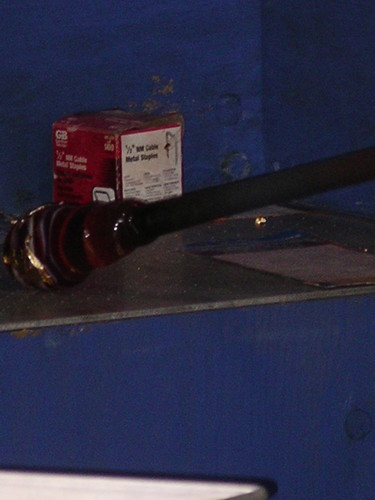In the beginning, the glass is heated on a pike in an oven. Then, other various colored glasses are attached onto the first, uncolored glass, then heated along with it. This forms a soupy-looking glass end on the pike.

At this point, techniques for adding designs into the glass come in. In this picture, you can see various little dots all over the glass. If the glass was left unmanipulated, it would simply come out covered in colored spots. Here, the artist has pulled down part of the glass at the top, farther away from the pike, down closer to the pike. This will create what is called a drape look. Only one drape has been added to this glass at this point, but typically artists add multiple drapes.

After the drapes have been added into the glass, it has to be reheated in the oven. This particular kind is referred to by artists as "the glory hole." (Glass artists were, up until the 70s, completely male, and this comes out sometimes in their choice of terminology.)

After being reheated, the glass has to be rolled again. The glass here is being rolled on a steel table, which absorbs much of the heat and cools it down again. If you look closely, you can clearly see one of the drape pulls in the design.

The glass is then rolled and reshaped with a wood bowl that looks similar to a spoon. The bowl sits in a bucket of water when it is not in use, and sometimes artists will redip the bowl while working with glass. This particular bowl is cheery, which is the kind preferred by glass artists, though any fruit wood works.

One of the last steps this artist chose was to add gold leaf. The gold leaf has to be rolled on, similar to the glass that has to be rolled on at the beginning of the process. Gold leaf is always one of the last steps of the process because it would vaporize if exposed to too much heat.

Next, the glass is blown to its full shape. The pike is howled out. Sometimes a tube is connected onto the opposite end of the pike and the artist blows to give the glass its full shape. You have to blow fairly hard at the beginning, and you have to blow harder as you go because the glass is stretching out and cooling down, making it harder to manipulate. At the same time the glass is being blown, the pike is being rolled in place so that the glass is even. (This is similar to working a pottery wheel, where the bowl is moving so that the designs will be even.)
As always, there are additional pictures on my Flikr page.
No comments:
Post a Comment